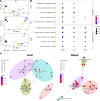Angiogenesis-associated pathways play critical roles in neonatal sepsis outcomes
- PMID: 38769383
- PMCID: PMC11106288
- DOI: 10.1038/s41598-024-62195-9
Angiogenesis-associated pathways play critical roles in neonatal sepsis outcomes
Abstract
Neonatal sepsis is a major cause of childhood mortality. Limited diagnostic tools and mechanistic insights have hampered our abilities to develop prophylactic or therapeutic interventions. Biomarkers in human neonatal sepsis have been repeatedly identified as associated with dysregulation of angiopoietin signaling and altered arachidonic acid metabolism. We here provide the mechanistic evidence in support of the relevance for these observations. Angiopoetin-1 (Ang-1), which promotes vascular integrity, was decreased in blood plasma of human and murine septic newborns. In preclinical models, administration of Ang-1 provided prophylactic protection from septic death. Arachidonic acid metabolism appears to be functionally connected to Ang-1 via reactive oxygen species (ROS) with a direct role of nitric oxide (NO). Strengthening this intersection via oral administration of arachidonic acid and/or the NO donor L-arginine provided prophylactic as well as therapeutic protection from septic death while also increasing plasma Ang-1 levels among septic newborns. Our data highlight that targeting angiogenesis-associated pathways with interventions that increase Ang-1 activity directly or indirectly through ROS/eNOS provide promising avenues to prevent and/or treat severe neonatal sepsis.
© 2024. The Author(s).
Conflict of interest statement
The authors declare no competing interests.
Figures





References
-
- Milton R, Gillespie D, Dyer C, Taiyari K, Carvalho MJ, Thomson K, et al. Neonatal sepsis and mortality in low-income and middle-income countries from a facility-based birth cohort: An international multisite prospective observational study. Lancet Glob. Health. 2022;10(5):e661–e672. doi: 10.1016/S2214-109X(22)00043-2. - DOI - PMC - PubMed
MeSH terms
Substances
LinkOut - more resources
Full Text Sources
Molecular Biology Databases
Miscellaneous

